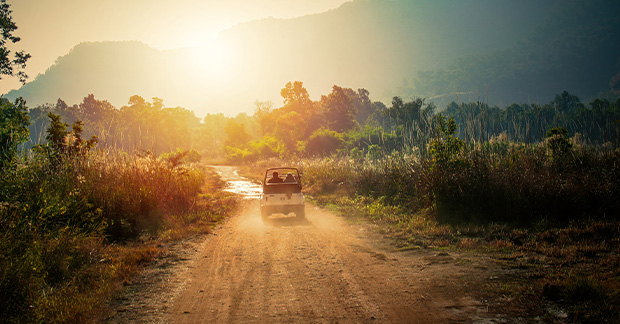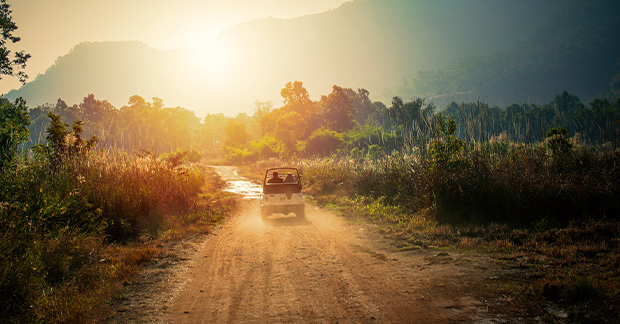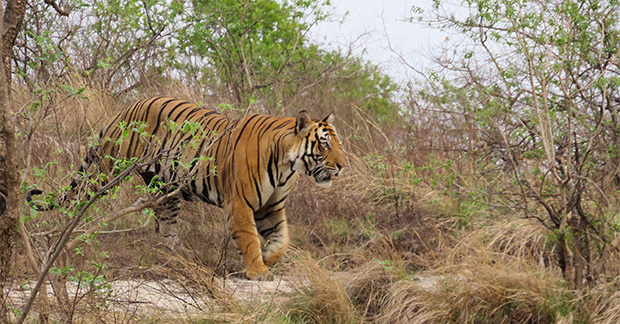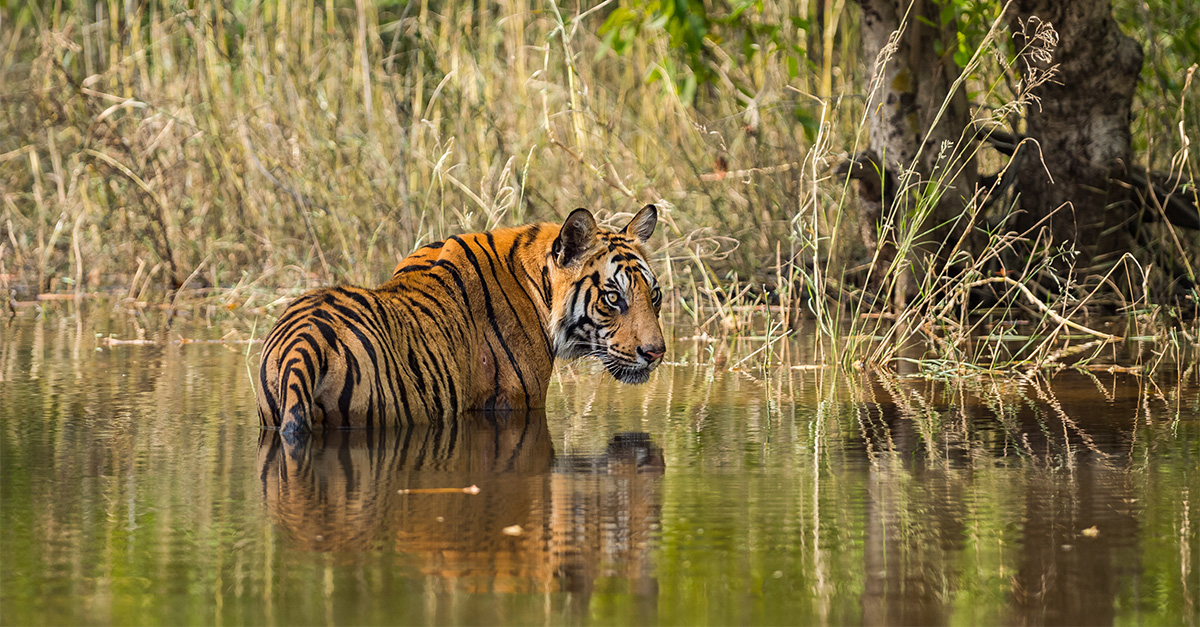You are viewing 2 of your 2 free articles
On a tiger safari in India’s conservation success story, Bandhavgarh National Park
Tamara Hinson heads to Bandhavgarh National Park, one of India’s best conservation success stories, in search of big cats
It takes a little over three hours to get from Jabalpur airport to the wonderfully wild Bandhavgarh National Park, which has one of India’s largest tiger populations.
The journey provides a fantastic insight into this part of India, whether it’s the vast grasslands or the tiny villages with their crowded markets and explosions of colour, courtesy of squat, pastel-hued buildings and the dhotis (orange scarves worn during religious ceremonies) draped around villagers’ necks.
Bandhavgarh National Park is one of India’s biggest conservation success stories. There are around 200 tigers here, some of which will – hopefully – use so-called green corridors to migrate to other wildlife reserves where populations are dwindling. This is how Bandhavgarh’s small elephant population arrived here in 2017, joining spectacular wildlife that includes leopards, wild boar, hyenas, jackals and civets.
Bandhavgarh Jungle Lodge is the perfect base, with 19 accommodations – six deluxe cottages, eight superior cottages and five villa rooms – nudging up against the park’s boundary. It takes less than five minutes to drive to the park’s nearest entrance (it’s divided into three zones, each with its own gate) and only a few minutes more to reach the others.
He summons me again, shining his light on a scorpion, before stamping his foot in the dust so I can watch the creature whip up its barb-topped tail
Long before I’ve set foot in the park, there’s a sense I’m already in it, and my favourite spot is my villa’s decking, from where I watch eagles swoop through the trees to a soundtrack of owl hoots.
The lodge was opened in 1992 by Pradeep Sankhala, son of legendary conservationist Kailash Sankhala, who led the Project Tiger programme. Today, it’s run by Pradeep’s son Amit, who shares the same passion for conservation and is a trustee of the Tiger Trust, founded by his grandfather.
I’ve yet to come across a lodge where every employee has such an all-consuming passion not only for wildlife, but for conservation. On my first night, a guide shows me a tiny scorpion hiding beneath a bush.
The eagerness with which I snap photos obviously doesn’t go unnoticed, because the next night the same member of staff summons me again, shining his light on an even larger scorpion, before stamping his foot in the dust so I can watch the creature whip up its barb-topped tail.

Passion for wildlife
This shared enthusiasm transforms my visit, whether it’s the guide showing me the aforementioned scorpion or resident naturalist Simranjit’s passion for species I could have easily overlooked. On one occasion, he points to a nondescript bird flitting around a folded leaf and explains it’s a tailorbird, so-called because it creates nests in leaves that it stitches together with grass.
Not that tigers aren’t number one on most people’s wish lists, closely followed by leopards and sloth bears. Long before my first tiger sighting it’s clear they are never far away.
Unlike on African safaris, on every Bandhavgarh safari drive there must be a tracker – a local expert who relies on sights, sounds and smells to find wildlife. And Bandhavgarh has some of the best, partly because guides and trackers can’t use radios to communicate with each other about sightings here.
The upside? When animals are seen, they’re less likely to be surrounded by multiple vehicles, which means more time to nail the perfect shot, or simply enjoy the moment. On my first day our tracker notices fresh tiger footprints, and lodge host and naturalist Sadhvi Singh spies sloth bear footprints moments after. Later, we hear the sound of a deer and our tracker’s ears prick up – it’s an alarm call, almost certainly relating to a tiger.

I’m desperate to see one – my last big cat sighting was of a collared tiger in Panna National Park, where I felt a pang of sympathy for the beast as five Jeeps with squawking radios jostled for space. Luckily, Bandhavgarh’s sheer size means there’s always something to observe.
By the end of my first day, I’ve seen wild boars, jackals, rattlesnakes, deer, civets, mongooses and vultures. I become so accustomed to seeing wild peacocks and langur monkeys that I no longer reach for my camera when another appears. I develop a new appreciation for birds, whether crested serpent eagles or red-throated flycatchers.
Only 20% of Bandhavgarh is open to the public, but the park’s size (to put it into perspective, at 600 square miles it’s only a tiny bit smaller than Hertfordshire) means there’s plenty of room to roam. It has expanded significantly over the years – something that has, according to lodge host Sadhvi, created myths worth flagging to potential clients.
In the same way we shouldn’t google our ailments, she advises potential visitors against googling which zone is best. Each has its own traits, and many online reviews that cite zone one as the best are outdated, written before the park’s expansion.

Spectacular sightings
Which zone I’m in makes no difference to the range or number of animal sightings, and each one is spectacular. I love zone two’s vast, watering hole-dotted grasslands, and I’m equally blown away by the forested valleys of zone one. This is where I spend my final day, on a hot, dry afternoon that appears to have lulled the park’s animals into a reclusive slumber.
And then it happens. As we rumble past a narrow gorge, a tiger ambles into view. For five minutes we watch in silence as the big cat – a male cub nearing adulthood – picks his way through the undergrowth, before pausing on a rocky outcrop, photo-ready and unfazed by our presence. He looks directly at us, steel-blue eyes focused with a laser-like intensity.
For five minutes we watch in silence as the big cat picks his way through the undergrowth, before pausing on a rocky outcrop, unfazed by our presence
Minutes later, he rises, just as we hear the rumble of a Jeep approaching. The family of five shoe-horned into another lodge’s vehicle instantly notices our raised cameras. Then a second Jeep appears, and both pull up just as the tiger slopes out of sight. The passengers tussle with camera lenses, but the tiger’s gone, and they look positively dismayed.
Simranjit announces it’s time to leave the park, and I feel slightly guilty – but undeniably smug – as we drive away, leaving the other Jeeps’ passengers to compare blurry photos of the retreating tiger, scanning the undergrowth in the hope of a second sighting but all too aware their time is up. On the plus side, I’m sure they saw some peacocks on their way out.
Ask the expert
James Jayasundera, managing director (and tiger fan) at Ampersand Travel

“Give yourself a minimum of five nights to maximise your chances of tiger sightings. Consider paying for a naturalist (most lodges will offer this). There’s no better way to elevate the experience because they’ll know not only about tigers but also the terrain, fauna and flora. Tigers are not the only interesting thing to see on safari!”
Top tip
Air Canada is launching new non-stop daily flights from Heathrow to Mumbai on October 30, 2022.
PICTURES: shutterstock/Sourabh Bharti/Images Of India; Tamara Hinson
Read more
x.travelweekly.co.uk/destinations/six-of-the-best-wildlife-spotting-holidays-around-the-world" target="_blank" target="_blank" target="_blank" target="_blank">Six of the best wildlife-spotting holidays around the world
x.travelweekly.co.uk/destinations/discover-the-wilder-side-of-asia-with-our-pick-of-the-best-nature-retreats" target="_blank" target="_blank" target="_blank" target="_blank">Discover the wilder side of Asia with our pick of the best nature retreats
x.travelweekly.co.uk/destinations/six-of-the-best-all-inclusive-stays-in-unusual-locations" target="_blank" target="_blank" target="_blank" target="_blank">Six of the best all-inclusive stays in unusual locations









